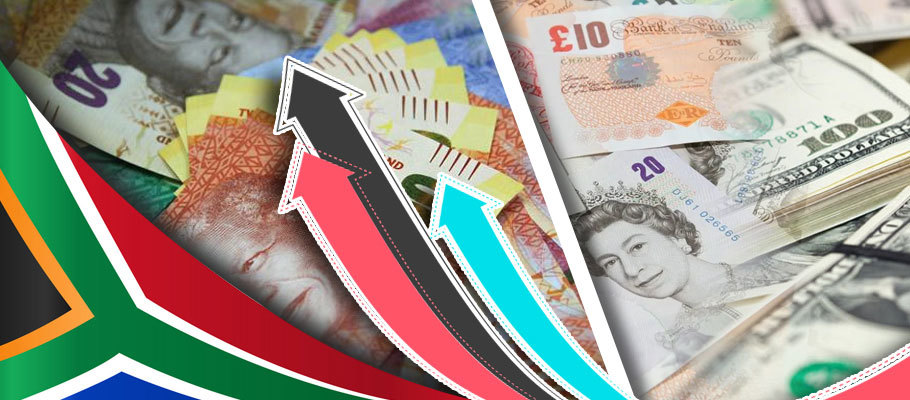
Published: August 6th, 2021
The South African rand (ZAR) has risen from two-month lows to outperform many of its peers as the new month begins, pushing the pound-to-rand exchange rate to below 20.00. The surprising price action was nudged by reduced enthusiasm for the American dollar (USD), although that could turn out to be a double-edged sword for ZAR bulls.
The rand was higher against every heavily traded currency in both developed and emerging market nations this week, the only exception being the Indonesian Rupiah, which continues a week-plus tear where its consistently exceeded market expectations.
Rand even shrugged off weaker-than-expected manufacturing PMI statistics, which dropped below what was thought to be likely in the consensus readings taken by economists for July.
South Africa has been torn by post-pandemic civil disorder, which has brought chaos to parts of the country, even as Pretoria had implemented draconian levels of coronavirus-related curbs on commercial activity, travel, and social contact.
Economists at Rand Merchant Bank in Johannesburg told Bloomberg on Thursday that investor sentiment has been negative recently ‘almost across the board.
‘The only light at the end of this tunnel we’ve seen is the improved outlook in expected business conditions six months down the road'.
Next week will see another round of economic data released when the IHS Markit manufacturing sector survey is published. At the moment, the consensus view is that indicators point to ZAR and many other currencies being carried aloft by a decline in the strength of the US dollar.
The greenback’s dip has been more readily visible since last week’s US Federal Reserve (Fed) monetary policy committee meeting.
On Wednesday, 28th July, Fed Chairman Jerome Powell and his colleagues on the Federal Open Market Committee (FOMC) essentially confirmed what had been expected: that they are now in the process of giving advance warning to markets, something that had been promised would occur before any decision was announced regarding a pullback in the central bank’s colossal USD 120 billion per month QE (quantitative easing) programme.
The Fed committed itself to ‘more and more clarity as it moves forward, Powell said. That means forex traders need to closely observe the coming FOMC policy sessions, especially in relation to the pace and timing of the bank's plan to decelerate its slate of monthly bond purchases.
One aspect that analysts say is holding the dollar back this week (while rand has gone up) is the Fed’s ambiguous use of language so far this quarter. By turns, the world's leading central bank has suggested its pandemic-driven monetary policy decisions are being made on a slower and more drawn out timeline than had been expected by much of the market.
The risk for dollar bulls is that an announcement with plans for the coming QE taper may not before the end of November or even later. That would be well after the September announcement many analysts believed was on the way.
This past Wednesday, forex strategists at Société Generale told Reuters that USD/ZAR had dropped back below 14.39 and that 'a pullback closer to 14.00 isn’t out of the question.’
Dollar declines have given the rand a healthy jolt over the likes of the British pound, with the GBP/ZAR exchange rate experiencing even steeper declines than those seen in USD/ZAR. That’s despite the fact the pound has outperformed many of its G10 currency peers over this past week.
‘Markets will now be watching payrolls and services data due out next week for direction,’ Société Generale strategists added. Mike McCormack, EMEA head of FX strategy at TD Securities, told Bloomberg that ‘Fed signals will be vital in the coming days as the central bank’s FOMC committee gives its views on whether the Fed is going to start tapering QE purchases sooner than expected.
With dollar news dominating trends this past week, the highlight for ZAR (and all currencies) will be the July US non-farm payrolls report due on Monday at 2:30 CEST. It will be a crucial bellwether indicator for markets jittery about the pace of the global recovery.
On the week commencing 26th July, Federal Reserve Chairman Powell said he would ‘want to see strong evidence that job numbers are improving and on an upward trend, not a blip,’ before he would be confident enough to say the American labour market has made ‘significant ongoing progress’ toward the ‘full employment’ status the Fed is seeking.
The non-farm payrolls report is even more vital for the Fed’s QE taper timescale, impacting the trajectory of the greenback due to elevated expectations by economists heading into the release. Market consensus points to a ‘big reveal’ of almost 900,000 jobs, either created new or re-activated from a COVID-imposed hiatus last month.
If that happens, it will be the second month in a row in which the US economy has generated close to one million jobs, a set of consecutive positive metrics and blockbuster job figures that America hasn’t seen since bouncing back from the first pandemic commercial restrictions in the second quarter of 2020.
For ZAR, it's a double-edged sword since lofty expectations for the US economy could quickly degenerate into disappointment if the numbers are less than hoped for, leading to further declines by the greenback. If the job numbers do hold up for a second month, however, the arrival of a back-to-back blockbuster jobs announcement could put September back on the table as a possible date for a QE taper announcement.
In June, US Federal Reserve Governor Christopher Waller Told The Wall Street Journal that he’d support tapering of asset purchases as early as September, but only if gains in employment numbers continue to move upward.